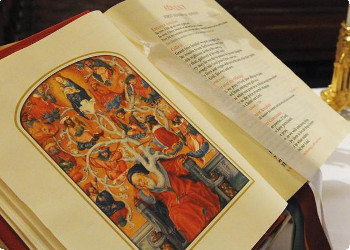Lord, if you wish, you can make me clean+
28 JUNE (Mt 8,1-4)
An example, that Jesus also reminds, of healing from leprosy in the Old Testament is Naaman the Syrian. Healing occurs in the waters of the Jordan by a command of Elisha. First, there is no contact between the leper and the prophet.
Naaman, the army commander of the king of Aram, was highly esteemed and respected by his master, for through him the Lord had brought victory to Aram. But valiant as he was, the man was a leper. Now the Arameans had captured from the land of Israel in a raid a little girl, who became the servant of Naaman’s wife. “If only my master would present himself to the prophet in Samaria,” she said to her mistress, “he would cure him of his leprosy.” Naaman went and told his lord just what the slave girl from the land of Israel had said. “Go,” said the king of Aram. “I will send along a letter to the king of Israel.” So Naaman set out, taking along ten silver talents, six thousand gold pieces, and ten festal garments. To the king of Israel he brought the letter, which read: “With this letter I am sending my servant Naaman to you, that you may cure him of his leprosy.” When he read the letter, the king of Israel tore his garments and exclaimed: “Am I a god with power over life and death, that this man should send someone to me to be cured of leprosy? Take note! You can see he is only looking for a quarrel with me!”
When Elisha, the man of God, heard that the king of Israel had torn his garments, he sent word to the king: “Why have you torn your garments? Let him come to me and find out that there is a prophet in Israel.” Naaman came with his horses and chariots and stopped at the door of Elisha’s house. The prophet sent him the message: “Go and wash seven times in the Jordan, and your flesh will heal, and you will be clean.” But Naaman went away angry, saying, “I thought that he would surely come out and stand there to invoke the Lord his God, and would move his hand over the spot, and thus cure the leprosy. Are not the rivers of Damascus, the Abana and the Pharpar, better than all the waters of Israel? Could I not wash in them and be cleansed?” With this, he turned about in anger and left. But his servants came up and reasoned with him. “My father,” they said, “if the prophet had told you to do something extraordinary, would you not have done it? All the more now, since he said to you, ‘Wash and be clean,’ should you do as he said.” So Naaman went down and plunged into the Jordan seven times at the word of the man of God. His flesh became again like the flesh of a little child, and he was clean (2Kings 5,1-14).
According to the Gospel of Matthew, Jesus begins his own works right with the healing of a leper. Why? The leper is a person excluded from the community, because of his contagious disease. Jesus comes to create of every man his family, his home and his kingdom. In his family there is no place for removal, separation, division of people into good and bad, just and unjust, healthy and sick, saints and sinners, impious and pious and idolaters and true worshipers. In it one body has to be formed, and every one must assume the life of the other. In his reign one lives for taking the weight of the other in order to carry it on his own shoulders. A community that does not assume the burdens of others, does not belong to Lord Jesus. It is not a community according to the Gospel.
When Jesus came down from the mountain, great crowds followed him. And then a leper approached, did him homage, and said, “Lord, if you wish, you can make me clean.” He stretched out his hand, touched him, and said, “I will do it. Be made clean.” His leprosy was cleansed immediately. Then Jesus said to him, “See that you tell no one, but go show yourself to the priest, and offer the gift that Moses prescribed; that will be proof for them.”
In the purification of this leper, the first work of Jesus, is signified the great value that the welcome must have for every disciple of Jesus. Not the good, the holy and the righteous must be welcome, but the lepers, plague victims and the spiritually and physically sick. Never might there subsist his kingdom, never his family and never his home where there is separation of life. God is communion, unity, sharing, togetherness, acceptance, mercy, pity, compassion and miracle. The Christian community must be able to perform these miracles of hospitality. However, it is not a matter of momentary, but of stable and permanent welcome. The other is the physical and spiritual part of us. With the other we are more than Siamese twins, because we are brothers in spirit.
Virgin Mary, Mother of the Redemption, Angels and Saints teach us the true hospitality.





